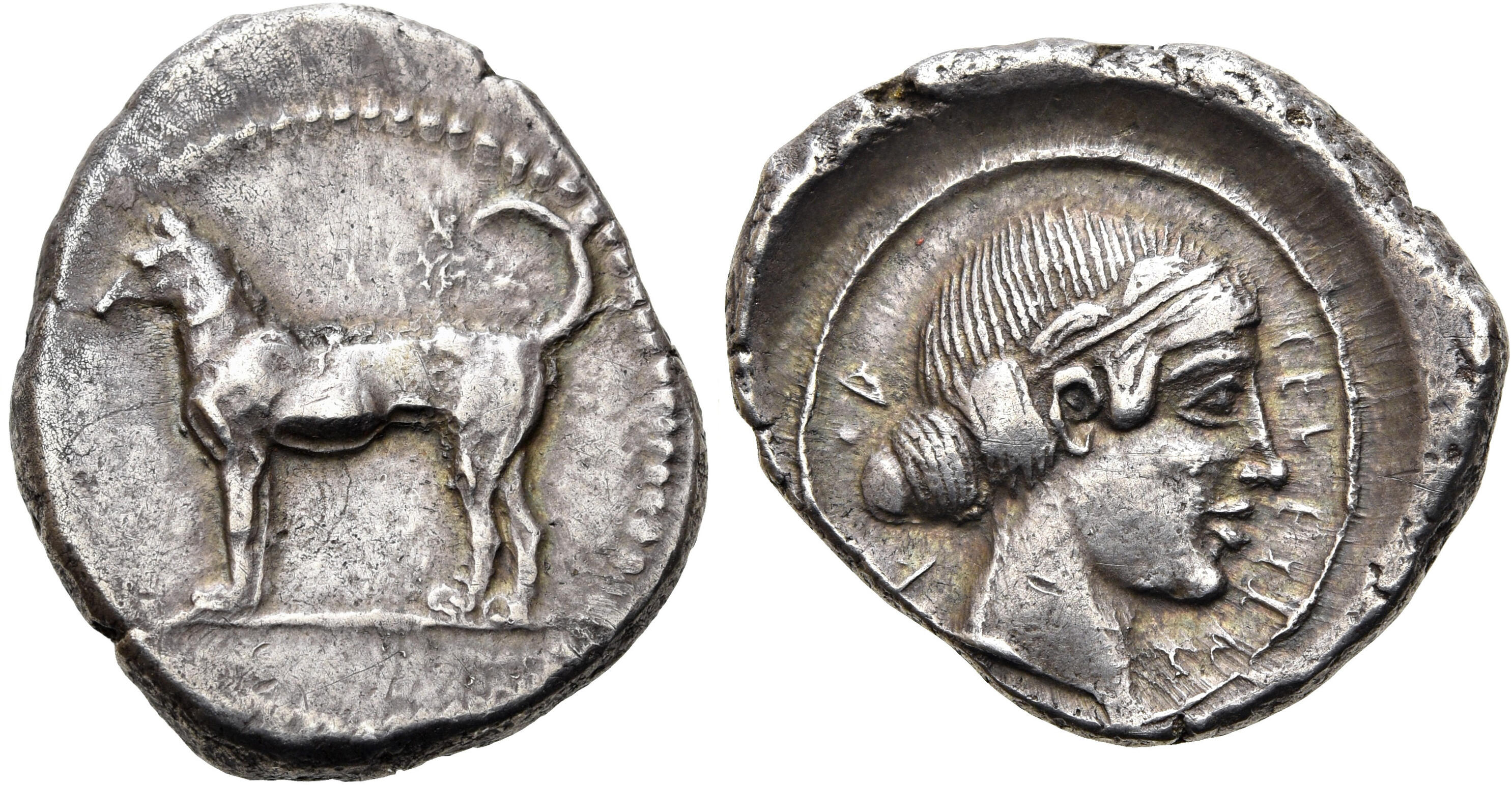Segesta, silver, didrachms (455-440 BCE)
From SILVER
455 BCE - 440 BCE Silver 1,649 kg
Description
| ObverseInscription or printing placed on the obverse.: | The river-god Krimisos, in the form of a hunting dog, standing left. |
| ReverseInscription or printing placed on the reverse.: | ΣΕΓΕΣΤΑZIB (Greek and Elymaic).Head of the nymph Aigeste to right, her hair bound with a ribbon |
Mint and issuing power
| MintIdentifies the place of manufacture or issue of a numismatic object.: | Segesta | Ancient regionAncient region.: | Sicily | Modern countryModern country: Italy | AuthorityIdentifies the issuing power. The authority can be "pretended" when the name or the portrait of X is on the coin but he/she was not the issuing power. It can also be "uncertain" when there is no mention of X on the coin but he/she was the issuing power according to the historical sources: |
Chronology
| FromIdentifies the initial date in a range assigned in a numismatic context. | 455 BCE | toIdentifies the final date in a range assigned in a numismatic context.. | 440 BCE | PeriodTime period of the numismatic object.: Classical 480-323 BC |
Physical description
| MetalThe physical material (usually metal) from which an object is made.: | Silver |
Median weightMedian of the weights of numismatic objects (in grams). in grams | 8.50 | DenominationTerm indicating the value of a numismatic object. Examples: tetradrachm, chalkous, denarius.: | didrachm |
StandardStandard.: |
Image

S 721 - Segesta, silver, didrachm, 455-440 BC.jpg [1]
References
| Die study referencePublication of the study: | Hurter 20081Hurter 2008, n° 60-96, pl. 6-8. | ||
| Coin series referenceReference to coin series study: | HGC 22HGC 2, n° 1127 | ||
| Coin series web referenceCoin series web references: | |||
Obverse dies distribution
| FrequencyFrequency of specimen in distribution. ᵖ | Number of obversesNumber of obverse dies. ᵖ (o) | % (o) | Number of coinsNumber of coins. (n) | % (n) | Die nameName(s) of the die(s). |
| 1 | 1 | 10 | 1 | 0.45 | 22 |
| 11 | 1 | 10 | 11 | 4.95 | 20 |
| 12 | 1 | 10 | 12 | 5.41 | 23 |
| 16 | 1 | 10 | 16 | 7.21 | 28 |
| 20 | 1 | 10 | 20 | 9.01 | 21 |
| 23 | 1 | 10 | 23 | 10.36 | 27 |
| 26 | 2 | 20 | 52 | 23.42 | 24, 26 |
| 35 | 1 | 10 | 35 | 15.77 | 25 |
| 52 | 1 | 10 | 52 | 23.42 | 29 |
| Total | 10 of 10 | 100 | 222 of 222 | 100 |
Reverse dies distribution
no distribution is available
Quantification
| Number of obversesNumber of obverse dies. ᵖ (o) | 10 | Number of singletons (o1)The number of singleton coins. ᵖ | 1 |
| Number of reverse diesNumber of reverse dies. (r) | 16 | Number of coinsNumber of coins. (n) | 222 |
| Coins per obverse dieNumber of coins per obverse die. (n/o) | 22.2 | Coins per reverse dieNumber of coins per reverse die. (n/r) | 13.88 |
| Reverse per obverse ratioRatio of obverse dies divided by reverse dies. (r/o) | 1.6 | Percentage of singletons (o1)number of coins (n) divided by the number of singletons (o1) ᵖ | 10 % |
| Original number of dies (O) (Carter 1983 formula)The estimation of the number of coins according to Carter 1983 ᵖ | 9.7 | Coins struck if 20,000 as average productivity per dieCoins made if the average productivity for obverses (according to Carter) is 20,000. ᵖ | 194,000 |
| Original number of dies (O) (Esty 2011 formula)The estimation of the number of coins according to the singleton formula in Esty 2011 ᵖ (O) | 10.47 | Survival rate if 20,000 as average productivity per dieSurvival rate if average productivity is 20,000. ᵖ | 0.00114 |
| Coverage (o = % of O) (Esty 1984 formula)Esty 1984 - coverage (% of O) ᵖ (o = % of O) | 99.55% | Die productivity if survival rate 1/2,000Average productivity if survival rate is 1/2,000. ᵖ | 45,773.2 |
| Weight of silver (in kg) if 20,000 coins per die (O = Carter formula)Carter 1983 * Median weight * 20000 (*10 if gold or electrum) ᵖ | 1,649 kg <br /> 1,649 kg | Die productivity if survival rate 1/5,000Average productivity if survival rate is 1/5,000. ᵖ | 114,432.99 |
Remarks
Most likely more than 2 workstations